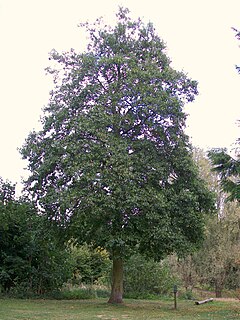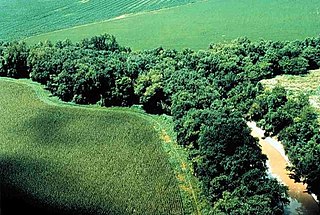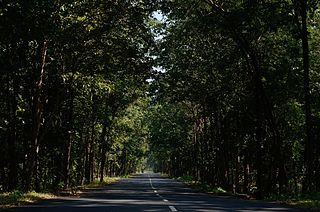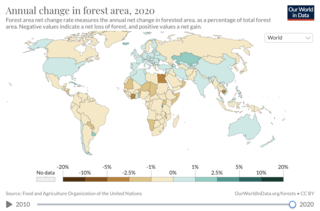Related Research Articles

Alders are trees comprising the genus Alnus in the birch family Betulaceae. The genus comprises about 35 species of monoecious trees and shrubs, a few reaching a large size, distributed throughout the north temperate zone with a few species extending into Central America, as well as the northern and southern Andes.

Reforestation is the natural or intentional restocking of existing forests and woodlands (forestation) that have been depleted, usually through deforestation, but also after clearcutting.

Betulaceae, the birch family, includes six genera of deciduous nut-bearing trees and shrubs, including the birches, alders, hazels, hornbeams, hazel-hornbeam, and hop-hornbeams numbering a total of 167 species. They are mostly natives of the temperate Northern Hemisphere, with a few species reaching the Southern Hemisphere in the Andes in South America. Their typical flowers are catkins and often appear before leaves.

Alnus glutinosa, the common alder, black alder, European alder, European black alder, or just alder, is a species of tree in the family Betulaceae, native to most of Europe, southwest Asia and northern Africa. It thrives in wet locations where its association with the bacterium Frankia alni enables it to grow in poor quality soils. It is a medium-sized, short-lived tree growing to a height of up to 30 metres (100 ft). It has short-stalked rounded leaves and separate male and female flowers in the form of catkins. The small, rounded fruits are cone-like and the seeds are dispersed by wind and water.

Alnus rubra, the red alder, is a deciduous broadleaf tree native to western North America.
The Black Country Urban Forest (BCUF) is a project to make urban forestry the characteristic landscape of one of England's industrial areas, The Black Country.

Alnus incana, the grey alder or speckled alder, is a species of tree in the birch family, with a wide range across the cooler parts of the Northern Hemisphere.

Greening Australia is an Australian environmental organisation, founded in 1982, the International Year of the Tree, to protect, restore and conserve Australia's native vegetation. Greening Australia was formed by the United Nations Association of Australia and the Nursery Industry Association of Australia.

Alnus cordata, the Italian alder, is a tree or shrub species belonging to the family Betulaceae, and native to the southern Apennine Mountains and the north-eastern mountains of Corsica. It has been introduced in Sicily and Sardinia, and more recently in Central-Northern Italy, other European countries and extra-European countries, where it has become naturalised.

Land development is altering the landscape in any number of ways such as:

Afforestation is the establishment of a forest or stand of trees (forestation) in an area where there was no previous tree cover. Many government and non-governmental organizations directly engage in afforestation programs to create forests and increase carbon capture. Afforestation is an increasingly sought-after method to fight climate concerns, as it is known to increase the soil quality and organic carbon levels into the soil, avoiding desertification.

A riparian zone or riparian area is the interface between land and a river or stream. Riparian is also the proper nomenclature for one of the terrestrial biomes of the Earth. Plant habitats and communities along the river margins and banks are called riparian vegetation, characterized by hydrophilic plants. Riparian zones are important in ecology, environmental resource management, and civil engineering because of their role in soil conservation, their habitat biodiversity, and the influence they have on fauna and aquatic ecosystems, including grasslands, woodlands, wetlands, or even non-vegetative areas. In some regions, the terms riparian woodland, riparian forest, riparian buffer zone,riparian corridor, and riparian strip are used to characterize a riparian zone. The word riparian is derived from Latin ripa, meaning "river bank".

Social forestry is the management and protection of forests and afforestation of barren and deforested lands with the purpose of helping environmental, social and rural development. The term social forestry was first used in 1976 by The National Commission on Agriculture, when the government of India aimed to reduce pressure on forests by planting trees on all unused and fallow lands. It was intended as a democratic approach to forest conservation and usage, maximizing land utilization for multiple purposes.

Frangula alnus, commonly known as alder buckthorn, glossy buckthorn, or breaking buckthorn, is a tall deciduous shrub in the family Rhamnaceae. Unlike other "buckthorns", alder buckthorn does not have thorns. It is native to Europe, northernmost Africa, and western Asia, from Ireland and Great Britain north to the 68th parallel in Scandinavia, east to central Siberia and Xinjiang in western China, and south to northern Morocco, Turkey, and the Alborz in Iran and Caucasus Mountains; in the northwest of its range, it is rare and scattered. It is also introduced and naturalised in eastern North America.

Frankia alni is a Gram-positive species of actinomycete filamentous bacterium that lives in symbiosis with actinorhizal plants in the genus Alnus. It is a nitrogen-fixing bacterium and forms nodules on the roots of alder trees.

Forest restoration is defined as “actions to re-instate ecological processes, which accelerate recovery of forest structure, ecological functioning and biodiversity levels towards those typical of climax forest” i.e. the end-stage of natural forest succession. Climax forests are relatively stable ecosystems that have developed the maximum biomass, structural complexity and species diversity that are possible within the limits imposed by climate and soil and without continued disturbance from humans. Climax forest is therefore the target ecosystem, which defines the ultimate aim of forest restoration. Since climate is a major factor that determines climax forest composition, global climate change may result in changing restoration aims.

The Japanese temperate rainforest is well sustained and maintains a high biodiversity. One method that has been utilized in maintaining the health of forests in Japan has been afforestation. The Japanese government and private businesses have set up multiple projects to plant native tree species in open areas scattered throughout the country. This practice has resulted in shifts in forest structure and a healthy temperate rainforest that maintains a high biodiversity.

Alnus alnobetula is a common tree widespread across much of Europe, Asia, and North America. Many sources refer to it as Alnus viridis, the green alder, but botanically this is considered an illegitimate name synonymous with Alnus alnobetula subsp. fruticosa.

Deforestation is a primary contributor to climate change. Land use changes, especially in the form of deforestation, are the second largest anthropogenic source of atmospheric carbon dioxide emissions, after fossil fuel combustion. Greenhouse gases are emitted during combustion of forest biomass and decomposition of remaining plant material and soil carbon. Global models and national greenhouse gas inventories give similar results for deforestation emissions. As of 2019, deforestation is responsible for about 11% of global greenhouse gas emissions. Carbon emissions from tropical deforestation are accelerating. Peatland degradation also emits GHG. Growing forests are a carbon sink with additional potential to mitigate the effects of climate change. Some of the effects of climate change, such as more wildfires, may increase deforestation. Deforestation comes in many forms: wildfire, agricultural clearcutting, livestock ranching, and logging for timber, among others. The vast majority of agricultural activity resulting in deforestation is subsidized by government tax revenue. Forests cover 31% of the land area on Earth and annually 75,700 square kilometers of the forest is lost. According to the World Resources Institute, there was a 12% increase in the loss of primary tropical forests from 2019 to 2020. Mass deforestation continues to threaten tropical forests, their biodiversity, and the ecosystem services they provide. The main area of concern of deforestation is in tropical rain forests since they are home to the majority of the planet's biodiversity.
Landscape genomics is one of many strategies used to identify relationships between environmental factors and the genetic adaptation of organisms in response to these factors. Landscape genomics combines aspects of landscape ecology, population genetics and landscape genetics. The latter addresses how landscape features influence the population structure and gene flow of organisms across time and space. The field of landscape genomics is distinct from landscape genetics in that it is not focused on the neutral genetic processes, but considers, in addition to neutral processes such as drift and gene flow, explicitly adaptive processes, i.e. the role of natural selection.
References
- Webber, J. 'Greening the Black Country: The Work of the Midland Reafforesting Association in the Early Twentieth Century', Arboricultural Journal, Vol.31, 2008, p45-62.
- Wise, M.J. ‘The Midland Reafforesting Association: 1903-1924 and the Reclamation of Derelict Land in the Black Country’, Journal of the Institute of Landscape Architects, Issue 57, 1962, p13-18.